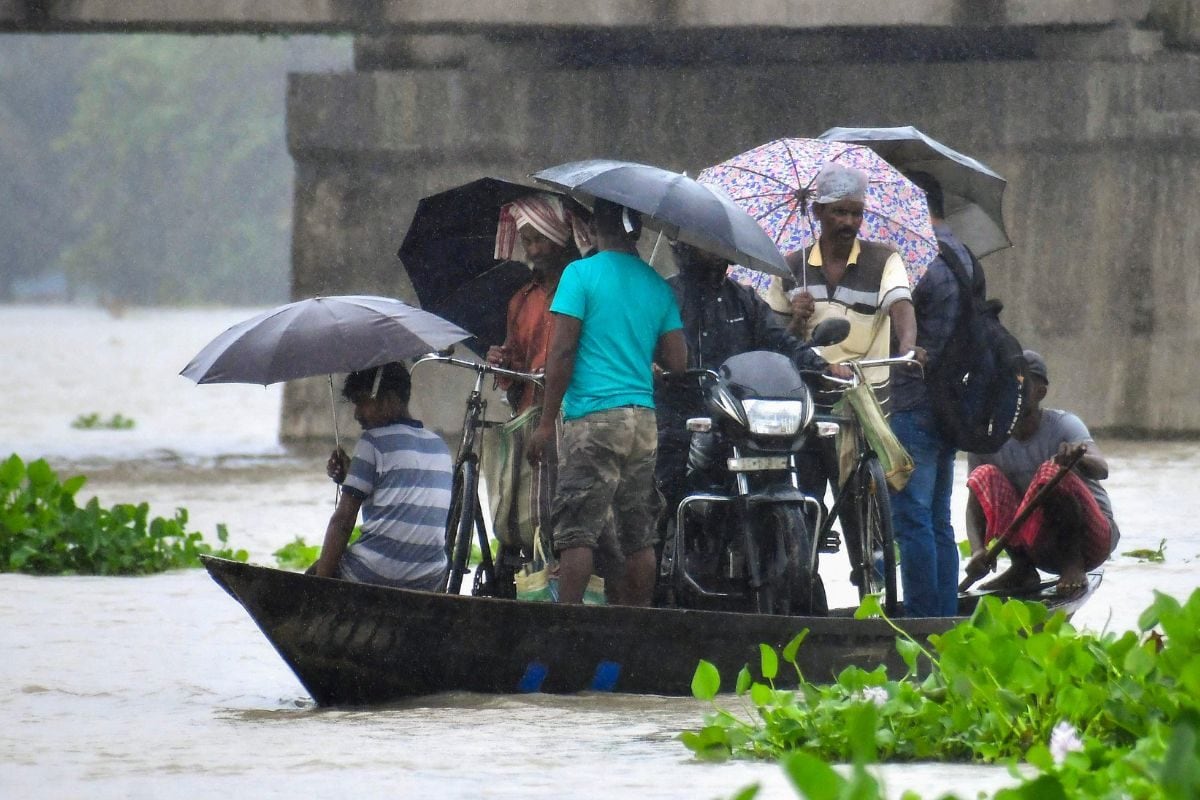
‘ASSAM FLOOD SITUATION CRITICAL, CHAOTIC’: 6 LAKH HIT, KAZIRANGA IMPACTED, HEAVY RAIN FORECAST FOR 2-3 DAYS
The flood situation in Assam has escalated to critical level, with over 6.44 lakh people affected across 19 districts, according to an official bulletin from the Assam State Disaster Management Authority (ASDMA). Eight rivers are currently flowing above the danger mark, including the Brahmaputra, which has breached its highest flood level at Nematighat in Jorhat district.
In a press conference held in Guwahati, Assam Chief Minister Himanta Biswa Sarma described the situation as chaotic and critical. “Very critical state awaits for Assam. We have been hit by massive floods. Lakhs of people have been affected until now and the numbers will increase in the next one week. Our rescue teams are on standby, ready to be deployed as necessary,” said Sarma.
He also said, “Prime Minister Narendra Modi and Union Home Minister Amit Shah called me and promised all help to deal with the situation.”
The Kaziranga National Park, a UNESCO World Heritage site known for its population of one-horned rhinoceroses, has been severely impacted. Nearly 95 forest check posts are submerged, forcing wildlife, including the endangered species, to migrate to nearby hills in search of safety.
The India Meteorological Department (IMD) has forecast heavy rainfall for the next two to three days, raising concerns about further deterioration of the flood situation.
As of now, a total of 6,44,128 people across the districts of Kamrup, Golaghat, Majuli, Lakhimpur, Karimganj, Cachar, Dhemaji, Morigaon, Udalguri, Dibrugarh, Tinsukia, Nagaon, Sivasagar, Darrang, Nalbari, Sonitpur, Tamulpur, Biswanath, and Jorhat are affected by the deluge. The ASDMA bulletin also noted that 2,70,628 people in 14 districts, including Brahmaputra and Barak valleys, are severely impacted.
Over 7,000 inmates are now in relief camps, and number of inmates not staying in relief camps is over 55,000.
CM Sarma said PM Modi will visit Assam to inspect the flood situation only if gets out of the hands of the chief minister.
Rescue operations are being carried out by multiple agencies, including the National Disaster Response Force (NDRF), State Disaster Response Force (SDRF), the army, the air force, and local administration. Coordinated efforts are focused on evacuating affected individuals, providing essential supplies, and ensuring the safety of the vulnerable populations.
The government has urged people in affected areas to remain vigilant and follow instructions from authorities to minimize the risk of casualties and further damage.
FLOOD IMPACT
- Meghalaya: Heavy rain has led to severe flooding and landslides across several districts. The East Khasi Hills and West Garo Hills are among the worst affected. Landslides have blocked roads, isolating villages and hampering rescue efforts. The state government has mobilized emergency response teams to clear debris and restore connectivity. Relief camps have been set up to shelter displaced families.
- Manipur: The Imphal River and other water bodies have overflowed, flooding residential areas and farmlands. The districts of Thoubal, Bishnupur, and Imphal East are experiencing significant waterlogging. The state disaster management authority is working with the central government to provide relief and support to the affected populations. Rescue teams are on alert, and essential supplies are being distributed to those in need.
- Mizoram: Incessant rain has caused the Tlawng, Tut, and Khawthlangtuipui rivers to swell, inundating several low-lying areas. The capital city, Aizawl, and the districts of Lunglei and Serchhip are facing severe flood conditions. The state government has issued warnings to residents in vulnerable areas and is coordinating with the NDRF for evacuation and relief operations.
- Tripura: The state is witnessing heavy rainfall, leading to flooding in the Gomati and Khowai districts. The overflowing rivers have submerged vast areas of agricultural land and residential zones. The state administration is closely monitoring the situation and has deployed disaster response teams to assist affected residents. Relief materials, including food, water, and medical supplies, are being distributed to flood-hit areas.
COORDINATED EFFORTS AND ONGOING CHALLENGES
The ongoing monsoon has placed immense pressure on the infrastructure and resources of these northeastern states. Authorities continue to monitor the situation closely, with efforts focused on minimizing casualties and providing relief to those impacted by the floods. The central government remains in close contact with state administrations to ensure a coordinated response to this widespread natural disaster.
With the situation still evolving, residents are advised to stay informed and heed warnings from local authorities. The collaborative efforts between state and central agencies aim to mitigate the impact of the floods and support affected communities during this challenging time.
2024-07-02T08:41:43Z dg43tfdfdgfd